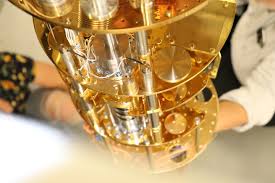Axions and HAYSTAC Experiment:

The HAYSTAC results, published in Physical Review Letters, marked a technological advance, even though no axions were detected. The experiment significantly expanded the parameter space of axion mass and coupling strength.
- Axions are hypothetical subatomic particles originally proposed in the late 1970s to explain the strong CP problem in quantum chromodynamics (QCD).
- They later emerged as one of the most promising candidates for dark matter.
- The axion’s role was to suppress CP-violating terms in QCD by dynamically adjusting the theta parameter (θ) to nearly zero.
- Over time, axions emerged as a leading dark matter candidate due to their unique properties: Electromagnetically neutral, Extremely light, Very weak interaction with ordinary matter and radiation.
- They are hypothesised to make up Cold Dark Matter (CDM)—the dominant form of dark matter thought to constitute ~85% of the universe’s matter content.
- Pioneering work by Sikivie, Wilczek, Dine, Preskill, and others showed that cosmological production of axions in the early universe could match observed dark matter density.
- The HAYSTAC experiment (Haloscope At Yale Sensitive To Axion Cold Dark Matter) is a collaborative initiative between Yale, Berkeley and Johns Hopkins, aimed at directly detecting axions by exploiting their potential to convert into photons within a strong magnetic field.
- The experiment uses a haloscope, a special type of detector designed by Pierre Sikivie—which incorporates a microwave cavity inside a powerful magnetic field.
- In its Phase II, HAYSTAC conducted the widest frequency search for dark matter axions to date. It introduced quantum squeezing techniques to reduce quantum noise, thereby enhancing the sensitivity of its haloscope detector.
- The HAYSTAC experiment and Advanced LIGO are currently the only two major physics experiments utilising quantum squeezing to improve precision in measurements.
- Quantum squeezing involves manipulating the uncertainty in quantum states to suppress random fluctuations, which improves the signal-to-noise ratio in weak signal detection, especially important for identifying rare particles like axions.




